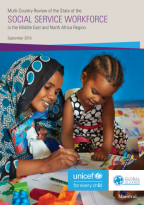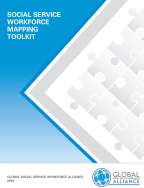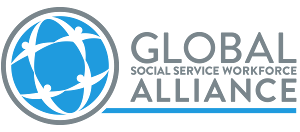The Alliance has developed and collaborated on a number of resources and tools to accelerate programming on social service workforce strengthening, and aid efforts to better plan, develop and support the social services workforce. We highly encourage the use of these resources and tools. If you translate any of the documents into other language please contact us, as the translations may be of use to others.
State of the Social Service Workforce Reports
The Alliance produced its first annual State of the Social Service Workforce Report in 2015 to shed light on key social service workforce trends, showcase innovative and effective workforce strengthening initiatives, and highlight this fairly new area of focus. Reports have been subsequently issued for 2016, 2017, 2018, 2020 and 2022 that include both qualitative and quantitative analyses of the workforce and make recommendations for future efforts to strengthen the workforce.
Regional Workforce Reviews
 The Alliance has produced regional, multi-country reviews, in coordination with UNICEF Regional Offices for the East Asia and Pacific region, Middle East and North Africa region and the South Asia region. The reviews provide an overview of the current status of the social service workforce in the region and identify good and promising practices for workforce strengthening in order to inform advocacy, legal, policy and strategy development and investment. Each report was compiled through a participatory mapping process outlined in the Social Service Workforce Mapping Toolkit.
The Alliance has produced regional, multi-country reviews, in coordination with UNICEF Regional Offices for the East Asia and Pacific region, Middle East and North Africa region and the South Asia region. The reviews provide an overview of the current status of the social service workforce in the region and identify good and promising practices for workforce strengthening in order to inform advocacy, legal, policy and strategy development and investment. Each report was compiled through a participatory mapping process outlined in the Social Service Workforce Mapping Toolkit.
Social Service Workforce Safety and Wellbeing during the COVID-19 Response
A well-supported, appropriately equipped, empowered, and protected social service workforce is essential to mitigating the damaging effects of the COVID-19 pandemic. Social service workers can build on their existing strong ties to children, families, and communities to rapidly respond in ways that are effective. However, to do so, they must stay safe and healthy. This technical note is intended to provide guidance on how to support the social service workforce and empower them to safely serve children, families, and communities during the COVID-19 pandemic. This guidance is for governments, non-governmental organizations, social service workers, and their supervisors. It is also available in Arabic, Spanish, French, Serbian, Portuguese and Farsi.
Guidelines to Strengthen the Social Service Workforce For Child Protection
These Guidelines, developed in consultation with UNICEF Headquarters and regional offices, are designed to accelerate programming on social service workforce strengthening with national and regional partners. Focusing on three key aspects of social service workforce strengthening—planning, developing and supporting—the guidelines highlight a series of interventions that focus on enhancing the capacity of the workforce to deliver promotive, preventative, and responsive interventions that support families and children in communities. Additionally, the guidelines provide examples of how social service workers provide these services by facilitating and coordinating efforts across various sectors.
Social Service Workforce Mapping Toolkit
 Workforce mapping is based on the premise that when the right number of workers are in the right positions and locations and have the right training, people will be able to access more effective and appropriate levels of care and support. This toolkit serves as a step-by-step, how-to guide for completing a national workforce mapping process. It packages tips, key considerations, sample tools, terms of reference and other guidance. As a result of completing this mapping process, groups will have data and information about the current status of the social service workforce in their country and will be better able to identify recommendations and strategies to improve the workforce going forward, thereby improving the quality of care available to children and families.
Workforce mapping is based on the premise that when the right number of workers are in the right positions and locations and have the right training, people will be able to access more effective and appropriate levels of care and support. This toolkit serves as a step-by-step, how-to guide for completing a national workforce mapping process. It packages tips, key considerations, sample tools, terms of reference and other guidance. As a result of completing this mapping process, groups will have data and information about the current status of the social service workforce in their country and will be better able to identify recommendations and strategies to improve the workforce going forward, thereby improving the quality of care available to children and families.
Results Matrix for Social Service Workforce Strengthening
This results matrix, developing in collaboration with UNICEF, is meant to guide the measurement of progress toward strengthening the social service workforce. Measuring progress against the specified indicators can help increase understanding of the impact of efforts to strengthen the social service workforce and of areas that need more attention. While this guide can be used by any organization interested in measuring progress toward workforce strengthening, it is ideally carried out as a process led and owned by a representative group of stakeholders across a given country, so that data is collected in an organized and harmonized way through partnership at the national level, with support from sub-national and community levels. This matrix is a companion piece to the Guidelines to Strengthen the Social Service Workforce for Child Protection and aligns with the Social Service Workforce Mapping Toolkit.
Proposed Guidance on Developing Minimum Social Service Workforce Ratios
An adequately planned, developed, and supported social service workforce is critical to enable equitable access to social protection and basic social welfare for all, in both development and humanitarian contexts. An important step in planning the required workforce is to establish a minimum social worker to population ratio and allocate resources for workforce development and support until the minimum ratio has been achieved, with the aim of ensuring sufficient quality of services to protect clients’ rights, promote their well-being and help them achieve their full potential. This guide aims to serve as a step-by-step guide, outlining key considerations for estimating minimum workforce ratios at the country level or for a specific local context, to enable equitable access to quality social services for all. This guidance can be used in correlation with our Proposed Guidance for Costing the Social Service Workforce.
Proposed Guidance for Costing the Social Service Workforce
Adequate investment in the social service workforce ensures that people in need can receive social services that are of sufficient quality to uphold their rights, promote their well-being and help them achieve their full potential. The purpose of this guidance is to advise policy makers and planners on how to apply a set of variables to their specific context to enable them to calculate the costs of human resources required to meet a target minimum ratio of social service workers per population, in the country in question. The guidance first discusses the essential steps that need to be taken to prepare for a costing exercise, and then the specific steps to take in a costing exercise for the workforce, which are outlined in the costing tool itself (to be released at a later date). This guidance can be used in correlation with our Proposed Guidance on Developing Minimum Social Service Workforce Ratios.
Guidance Manual on Strengthening Supervision for the Social Service Workforce
Effective supervision results in improved quality of service to clients, reduced risk of poor practice owing to stronger reflection in action, integration of knowledge and research in daily practice, and reduced worker stress and burnout. The purpose of this manual is to offer guidance on supervision to individuals working to provide, manage or coordinate social services. This manual defines what is meant by supervision in social services, outlines the key elements of good practice in supervision and summarizes the different forms of supervision. It also presents general recommendations as well as specific case examples and draws from documented best practices. It is the hope that readers will gain greater awareness of the significant positive benefits of supervision and key elements of carrying out quality supervision.
Social Service Workers in Health Facilities: Their Role in Addressing Social and Other Determinants of Health Among Children and Families
Social determinants of health—such as income, education, food and housing—have a substantial influence on individual health outcomes as well as on health inequities within and between countries. With a social service workforce working in and linked to health facilities, there is much more potential for health systems to not only address clinical needs effectively and efficiently, but to tackle the inequities present in health care provision itself and to work towards more just, people-centered health systems and universal health coverage, in line with Sustainable Development Goal 3. This paper aims to enable policy makers, civil society and advocacy groups to better articulate the value of the social service workforce in health systems through a presentation of the latest evidence on social service workforce roles, functions and promising practice models, and related influence on health outcomes and costs. Based on interviews, research and data from a range of countries, it outlines key challenges, opportunities and recommendations around effective and sustained deployment of the social service workforce when located in or linked to health facilities.
Social Service Workers in Schools: Their role in addressing violence against children and other child protection concerns
Schools can play a critical role in addressing violence against children and other child protection concerns within schools and communities. This role and responsibility can be best fulfilled with the help of on-site support staff, including social service workers. This technical note, developed in collaboration with UNICEF, provides ten key recommendations for how child protection concerns can be addressed in schools and defines the services that the social service workforce, if sufficiently resourced and supported, could provide working in or with schools, and which school administrators and leaders would need to support. It also outlines the multi-agency child protection services in or linked to schools that governments and ministries of education should support in order to uphold children’s right to learning and protection from all forms of violence.
The Role of Social Service Workforce Development in Care Reform
Protecting children without adequate family care is a challenge faced by families, communities, and governments in every country in the world. Millions of children are separated from their families and living in alternative care even though most have at least one living parent or relative willing to care for them with the right support. There is growing recognition of the central role of family and child development and well-being, and of the detrimental impact that loss of family care has on children. Increasing numbers of countries are working to make changes to their child care systems and mechanisms to promote and strengthen the capacity of families, prevent separation, and ensure appropriate family-based alternative care options are available. A strong social service workforce is integral to these care reforms. This working paper explores the topic of social service workforce strengthening as it relates to child care reform drawing from examples in Indonesia, Moldova and Rwanda. It is intended to be a useful resource for reform efforts and a practical and accessible overview for use by policy-makers, practitioners and service providers in contexts that are either considering the implications of care reforms for their social service workforce or are already engaged in a process and are searching for strategies to align and increase the effectiveness of the workforce to implement care reforms.
Global Advocacy Toolkit for the Social Service Workforce
The social service workforce stands on the front lines of addressing the most pressing issues facing our societies today, but the impact of their work depends on receiving the proper political and financial support. Failing to strengthen the workforce means limiting the effectiveness of programs and wasting valuable resources. The Global Advocacy Toolkit for the Social Service Workforce provides advocates with a common set of tools and messages with which to bring about greater political and programmatic priority for strengthening the social service workforce. This Toolkit is research-based, solutions-focused and includes lessons from behavioral science and original research on the most effective ways to communicate to policy and decision-makers. It includes case studies, stories, fact sheets and infographics, which can be used individually or together.
Core Concepts and Principles of Effective Case Management & the Case Management Compendium
The use of quality case management practices has been shown to improve decision-making and service delivery in child welfare and protection, which reduces violence against children, prevents unnecessary family separation, and improves child and family outcomes. Core Concepts and Principles of Effective Case Management supports the social service workers responsible for implementing a case management process, by articulating the main principles and concepts of case management as well as by serving as a guide to help inform or reflect upon local and contextualized approaches.
The compendium is a compilation of case management tools and resources organized under the following themes: core concepts and principles, tools and forms, standard operating procedures and training materials. It is intended to be useful to audiences of various workforce levels and organizations, representing practices from humanitarian and development perspectives across different regions. Both the compendium and Core Concepts and Principles of Effective Case Management are the work of the Alliance Case Management Interest Group.
Access the principles of effective case management Access the compendium
Para Professionals in the Social Service Workforce: Guiding Principles, Functions and Competencies
While community level workers, often para professionals, provide an array of social services in various countries across the globe, the functions and activities of these workers are not well described or delineated within or across countries. Training, credentialing, supervision and evaluation of para professional community social services vary as well based on local context. This document frovides guidance for developing programs and activities related to how para professionals can be trained, developed, deployed and supported, and a competency framework to provide program guidance, accountability and ultimately inform both training and supervision. The first edition was released in September 2015 and second edition in 2017. The second edition includes competencies for two new sets of workers - Para Professional Social Workers and Para Professional Community Development Workers. Également disponible en Français.
The Alliance has also developed a curated list of resources specifically relevant to planning, developing and supporting the para professional workforce. These tools are selected from a wider array of relevant tools you can find in our resource database and are intended to feature practical information and actions necessary for strengthening the para professional social service workforce.
Additional Resources and Tool
-
Review of Legislation and Policies that Support the Social Service Workforce in Low- and Middle-Income Countries: A snapshot of social service workforce-supportive policies and legislation in selected countries and provides examples of aspects of legislation that feature the workforce.
-
Evidence Base on the Social Service Workforce: Current Knowledge, Gaps and Future Research Direction: This report aims to establish a clearer picture of the state of the current evidence, identify evidence gaps and suggest priority research needs.
-
Evidence Matrix for the Social Service Workforce:The matrix was developed using key words and accessing multiple data libraries and search engines to explore academic and grey literature as it relates to the Framework for Strengthening the Social Service Workforce Alliance. This document is meant to be a "living" document and was used to inform the Evidence Base Report.
-
The Composition of the Social Service Workforce in HIV/AIDS-Affected Contexts: Provides a description of the composition of the social service workforce, including typical functions, titles, and levels and types of education and training.
-
Under Recognized Cadres of HRH in Africa: Professionalizing the Social Service Workforce: Data and examples of the workforce in Africa, including recommendations for greater support
-
Recruitment and Retention of Social Work Faculty: A multi-country review:Consolidates main challenges and effective strategies related to faculty recruitment and retention around the world.
